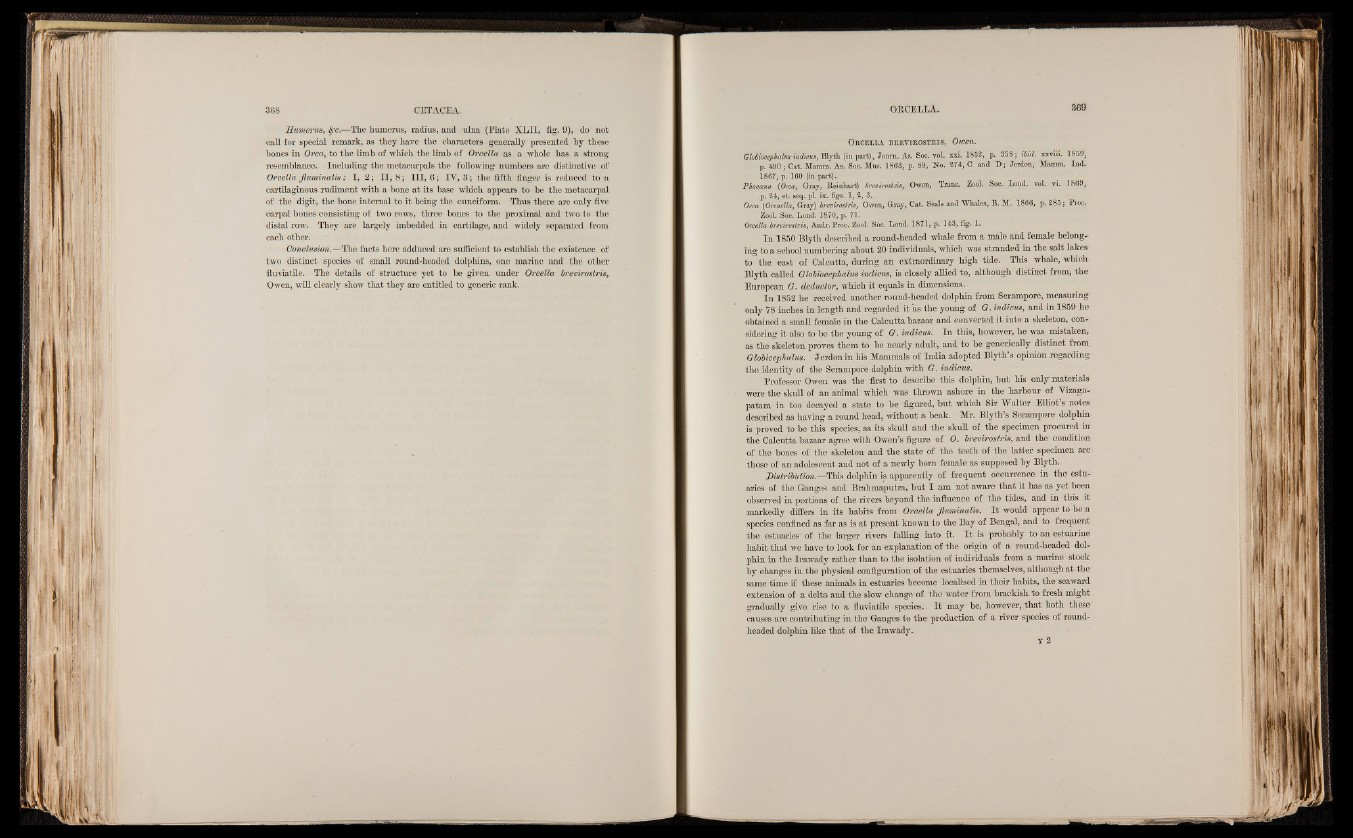
Humerus, 8fc.—The humerus, radius, and ulna (Plate XLII, fig. 9), do not
call for special remark, as they have the characters generally presented by these
bones in Orca, to the limb of which the limb of Orcella as a whole has a strong
resemblance. Including the metacarpals the following numbers are distinctive of
Orcella fluminalis: I, 2; II, 8; III, 6 ; IV, 3; the fifth finger is reduced to a
cartilaginous rudiment with a bone at its base which appears to be the metacarpal
of the digit, the bone internal to it being the cuneiform. Thus there are only five
carpal bones consisting of two rows, three bones to the proximal and two to the
distal row; They are largely imbedded in cartilage, and widely separated from
each other;
Conclusion.—The facts here adduced are sufficient to establish the existence of
two distinct species of small round-headed dolphins, one marine and the other
fluviatile. The details of structure yet to be given under Orcella brevirostris,
Owen, will clearly show that they are entitled to generic rank.
O r c e l l a b r e v ir o s t r i s , Owen.
Globiocephalus ihdicus, Blyth (in part), Journ. As. Soc. vol. xxi. 1852, p. 858; ibid. xxviii. 1859,
p. 490; Cat. Mamm. As. Soc. Mas. 1863, p. 89, No. 274, C and D ; Jerdon, Maxrnn. Ind.
1867, p. 160 (in p art).,
Phocana (Orca, Gray, Reinhart) brevirostris, Owen, Trans. Zool. Soc. Lond. vol. vi. 1869,
p. 24, et. seq. pi. ix. figs. 1, 2, 3.
Orca (Orcaella, Gray) brevirostris, Owen, Gray, Cat. S6als and Whales, B. M. 1866, p. 285; Proc.
Zool. Soc. Lond. 1870, p. 71.
Orcella brevirostris, Andr. Proc. Zool. Soc. Lond. 1871, p. 143, fig. 1.
In 1850 Blyth described a round-headed whale from a male and female belonging
to a school numbering about 20 individuals, which was stranded in the salt lakes
to the east of Calcutta, during an extraordinary high tide. This whale, which
Blyth called Globiocephalus indicus, is closely allied to, although distinct from, the
European G. deductor, which it equals in dimensions.
In 1852 he received another round-headed dolphin from Serampore, measuring
only 78 inches in length and regarded it as the young of G. indicus, and in 1859 he
obtained a sma.11 female in the Calcutta bazaar and converted it into a skeleton, considering
it also to be the young of G. indicus. In this, however, he was mistaken,
as the skeleton proves them to be nearly adult, and to be generically distinct from
Globicephalus. Jerdon in his Mammals of India adopted Blyth’s opinion regarding
the identity of the Serampore dolphin with G. indicus.
Professor Owen was the first to describe this dolphin, but his only materials
were the skull of an animal which was thrown ashore in the harbour of Vizaga-
patam in too decayed a state to be figured, but which Sir Walter Elliots notes
described as having a round head, without a beak. Mr. Blyth s Serampore dolphin
is proved to be this species, as its skull and the skull of the specimen procured in
the Calcutta bazaar agree with Owen’s figure of O. brevirostris, and the condition
of the bones of the skeleton and the state of the teeth of the latter specimen are
those of an adolescent and not of a newly bom female as supposed by Blyth.
Distribution.—This dolphin is apparently of frequent occurrence in the estu--
aries of the Ganges and Brahmaputra, but I am not aware that it has as yet been
observed in portions of the rivers beyond the influence of the tides, and in this it
markedly differs in its habits from Orcella fluminalis. I t would appear to be a
species confined as far as is at present known to the Bay of Bengal, and to frequent
the estuaries' of the larger rivers falling into it. I t is probably to an estuarine
habit that we have to look for an explanation of the origin of a round-headed dolphin
in the Irawady rather than to the isolation of individuals from a marine stock
by changes in the physical configuration of the. estuaries themselves, although at the
same time if these animals in estuaries become localised in their habits, the seaward
extension of a delta and the slow change of the water from brackish to fresh might
gradually give rise to a fluviatile species. I t may be, however, that both these
causes are contributing in the Ganges to the production of a river species of round-
headed dolphin like that of the Irawady.